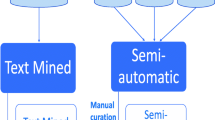Abstract
Biological ontologies, such as the Human Phenotype Ontology (HPO) and the Gene Ontology (GO), are extensively used in biomedical research to investigate the complex relationship that exists between the phenome and the genome. The interpretation of the encoded information requires methods that efficiently interoperate between multiple ontologies providing molecular details of disease-related features. To this aim, we present GenOtype PHenotype ExplOrer (GOPHER), a framework to infer associations between HPO and GO terms harnessing machine learning and large-scale parallelism and scalability in High-Performance Computing. The method enables to map genotypic features to phenotypic features thus providing a valid tool for bridging functional and pathological annotations. GOPHER can improve the interpretation of molecular processes involved in pathological conditions, displaying a vast range of applications in biomedicine.
Access this chapter
Tax calculation will be finalised at checkout
Purchases are for personal use only
Similar content being viewed by others
Notes
- 1.
Vectors are parallel-friendly structures that allow to easily split the elements among different compute elements.
- 2.
Path frequencies for connected pairs are computed without considering the edges that directly connect the phenotype and genotype to the same gene, to avoid biasing the model towards already existing pairs.
References
What exactly are genomes: genotypes and phenotypes? And what about phenomes? J. Theor. Biol. 186(1), 55–63 (1997)
Garcia, M., Labarta, J., Corbalan, J.: Hints to improve automatic load balancing with LeWI for hybrid applications. J. Parallel Distrib. Comput. 74(9), 2781–2794 (2014)
Embracing complex associations in common traits: Critical considerations for precision medicine. Trends Genet. 32(8), 470–484 (2016)
Garcia, M., Labarta, J., Corbalan, J.: Evaluating the clinical validity of gene-disease associations: an evidence-based framework developed by the clinical genome resource. Am. J. Hum. Genet. 100(6), 895–906 (2017)
Choi, N., Song, I.Y., Han, H.: A survey on ontology mapping. ACM Sigmod Rec. 35(3), 34–41 (2006)
Cirillo, D., Valencia, A.: Big data analytics for personalized medicine. Curr. Opin. Biotechnol. 58, 161–167 (2019). https://doi.org/10.1016/j.copbio.2019.03.004. SBN
Duran, A., Ayguadé, E., Badia, R.M., et al.: OmpSs: a proposal for programming heterogeneous multi-core architectures. Parallel Process. Lett. 21(2), 173–193 (2011)
Garcia-Gasulla, M., Josep-Fabrego, M., Eguzkitza, B., Mantovani, F.: Computational fluid and particle dynamics simulations for respiratory system: Runtime optimization on an arm cluster. In: Proceedings of the 47th International Conference on Parallel Processing Companion, p. 11. ACM (2018)
Gkoutos, G.V., Schofield, P.N., Hoehndorf, R.: The anatomy of phenotype ontologies: principles, properties and applications. Briefings Bioinform. 19(5), 1008–1021 (2017)
Halevy, A., Norvig, P., Pereira, F.: The unreasonable effectiveness of data. IEEE Intell. Syst. 24(2), 8–12 (2009)
Hoehndorf, R., Schofield, P.N., Gkoutos, G.V.: The role of ontologies in biological and biomedical research: a functional perspective. Briefings Bioinform. 16(6), 1069–1080 (2015). https://doi.org/10.1093/bib/bbv011
Köhler, S., Carmody, L., Vasilevsky, N., et al.: Expansion of the Human Phenotype Ontology (HPO) knowledge base and resources. Nucleic Acids Res. 47(D1), D1018–D1027 (2018). https://doi.org/10.1093/nar/gky1105
Message Passing Interface Forum: MPI: A message-passing interface standard. Version 3.1. University of Tennessee, June 2015
OpenMP Architecture Review Board: OpenMP Application Programming Interface, version 5.0 (2018)
Rhee, S.Y., Wood, V., Dolinski, K., Draghici, S.: Use and misuse of the gene ontology annotations. Nat. Rev. Genet. 9, 509–515 (2008)
Schulze-Kremer, S.: Ontologies for molecular biology and bioinformatics. In Silico Biol. 2, 179–93 (2002)
Shefchek, K.A., Harris, N.L., Gargano, M., et al.: The Monarch Initiative in 2019: an integrative data and analytic platform connecting phenotypes to genotypes across species. Nucleic Acids Res. 48(D1), D704–D715 (2019). https://doi.org/10.1093/nar/gkz997
Smith, B., Ashburner, M., Rosse, C., Bard, J., et al.: The obo foundry: coordinated evolution of ontologies to support biomedical data integration. Nat. Biotechnol. 25, 1251–5 (2007)
Tam, V., Patel, N., Turcotte, M., Bossé, Y., Paré, G., Meyre, D.: Benefits and limitations of genome-wide association studies. Nat. Rev. Genet. 20, 467–484 (2019)
The Gene Ontology Consortium: The gene ontology resource: 20 years and still GOing strong. Nucleic Acids Res. 47(D1), D330–D338 (2018)
Tomczak, A., et al.: Interpretation of biological experiments changes with evolution of the gene ontology and its annotations. Sci. Rep. 8(1), 1–10 (2018)
Zhang, W., Zhang, H., Yang, H., et al.: Computational resources associating diseases with genotypes, phenotypes and exposures. Briefings Bioinform. 20(6), 2098–2115 (2018)
Acknowledgements
This work has been developed with the support of the Severo Ochoa Program (SEV-2015-0493); the Spanish Ministry of Science and Innovation (TIN2015-65316-P); and the Joint Study Agreement no. W156463 under the IBM/BSC Deep Learning Center agreement.
Author information
Authors and Affiliations
Corresponding author
Editor information
Editors and Affiliations
Rights and permissions
Copyright information
© 2020 Springer Nature Switzerland AG
About this paper
Cite this paper
Josep-Fabregó, M. et al. (2020). GOPHER, an HPC Framework for Large Scale Graph Exploration and Inference. In: Jagode, H., Anzt, H., Juckeland, G., Ltaief, H. (eds) High Performance Computing. ISC High Performance 2020. Lecture Notes in Computer Science(), vol 12321. Springer, Cham. https://doi.org/10.1007/978-3-030-59851-8_13
Download citation
DOI: https://doi.org/10.1007/978-3-030-59851-8_13
Published:
Publisher Name: Springer, Cham
Print ISBN: 978-3-030-59850-1
Online ISBN: 978-3-030-59851-8
eBook Packages: Computer ScienceComputer Science (R0)




